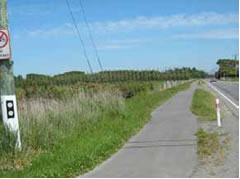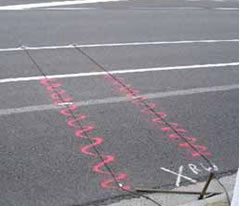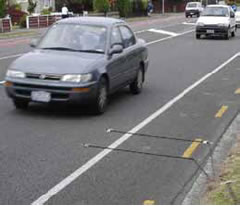
These guidelines are to assist in the installation of MetroCount 5600 traffic counters when counting cycles. The manufacturer's instructions should be used as the main source of advice when using any automated traffic counters. These guidelines have been prepared by MWH New Zealand Ltd and ViaStrada Ltd to complement information from MetroCount and are provided in good faith; however, no responsibility for the results achieved by following these guidelines is accepted. Those counting cycle traffic should use their best judgement and, if in doubt, seek assistance from MetroCount directly.
The setup for counting cycles is similar to that for classified counts for motor vehicles (two tubes). The main differences are the tube type used and some layout considerations.
The tubes used for counting cycles are smaller and softer than those used for motor vehicles, but the setup parameters are the same. The softer tubes mean that it is preferable to minimise the amount of motor vehicle traffic across the tubes, to minimise damage by trucks in particular. MetroCount 5600 counters can easily distinguish between motor vehicles and cycles, but as with most automatic counters, if there are multiple simultaneous ‘hits’, the counter is likely to be confused. The length of tubes should be limited to 7 m.
The layout for off-road paths is simple. The tubes should traverse the entire path, with care taken not to place tubes in the vicinity of obstacles (such as overhanging trees, etc) that may affect cyclists' behaviour or trajectory. A typical installation is illustrated in figure A1.
Figure A1 - Typical off-road path counting installation


A separate counter should be set up on each side of the road, with tubes extending into the road only as far as necessary to record cycles, based on observation of where cyclists actually ride. This minimises the recording of motor vehicles, which may reduce the accuracy of the cycle counts if traffic volumes are high.
The tubes should be installed on uniform mid-block sections of road. Try to avoid getting too close to intersections where there may be ‘intersection noise’, such as left-turn lanes.
Avoid placing the tubes near service lids such as fire hydrants, valve covers, etc, as cyclists often try to avoid these and they may miss the tubes in the process.
Where possible, avoid placing the tubes in areas where parking exists, as a car parked on a tube will stop that tube from detecting cycles. If car parking can't be avoided, assess the parking demand. For an area with high parking demand, the tubes should be fenced or coned off. If the area has low parking demand, then it may be preferable to not use cones, which would highlight the presence of the tubes and increase the risk of vandalism. Spray painting the road and the tubes in the parking area with a pseudo crosshatching (as shown in figure A2) can be beneficial.
If the tubes are being placed across a cycle lane, they should extend approximately 400 mm beyond the cycle lane line (measured from the centre of the line to the end of the tube), as shown in figure A3. This provides space to secure the tubes with straps well clear of the cycle lane, to encourage cyclists to ride over the tubes.

Figure A2 – Spray painting tubes to discourage parking where parking demand is low

Figure A3 – Tubes extend 400 mm beyond the cycle lane or edge line
If the tubes are being placed on a section of road with no cycle lanes, then as a general rule of thumb the tubes should extend to 40 percent of the traffic lane width. For example, on a traffic lane 4 m wide, the tubes should extend 1.6 m from the kerb, edge line or car parking line.